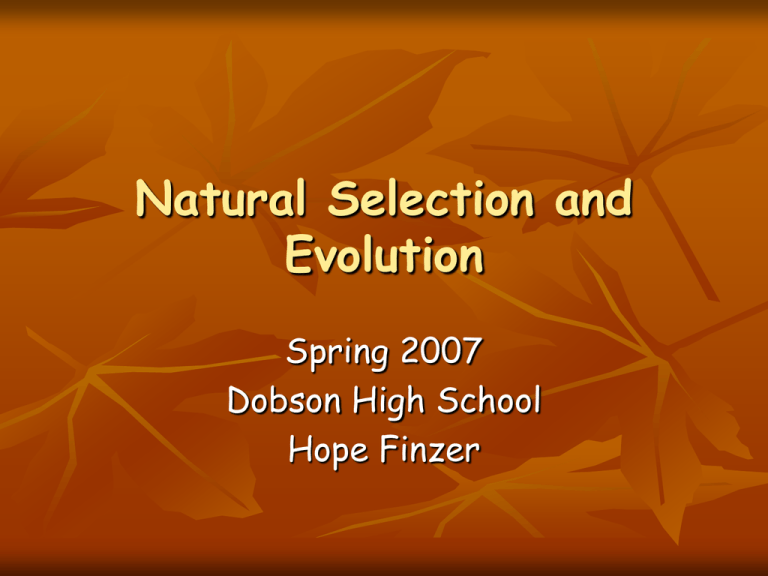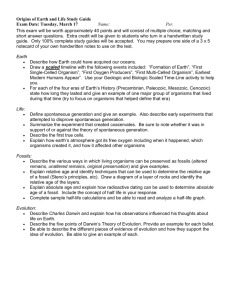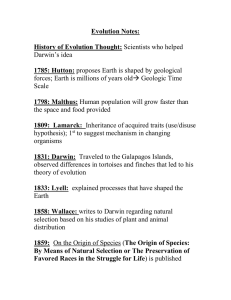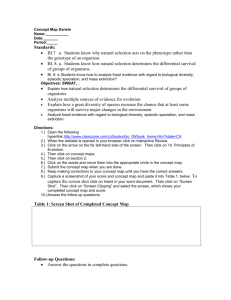Natural Selection and Evolution Spring 2007 Dobson High School
advertisement

Natural Selection and Evolution Spring 2007 Dobson High School Hope Finzer Earth’s History Earth Origins: 4.6 billion years old – originally a ball of hot molten rock – bombarded by meteorites and extreme volcanic activity – the atmosphere was inhospitable but volcanic gases paved the way for our current atmosphere Earth’s History Earth’s Oceans: Formed about 3.9 billion years ago after the Earth began to cool and allow the water vapor to condense into water forming the oceans – its is in these oceans that the first living organisms appeared 3.5 billion years ago History in the Rocks Fossils: Any evidence of an organism that lived long ago – classified by how the fossil is formed Types of fossils: CastsA mold of an organism filled by minerals in the surrounding rock – produces a replica Trace FossilsMarkings or evidence of animal activities – footprints, trails, and burrows History in the Rocks Types of fossils: ImprintsFossils that form before sediment hardens into rock – leaves or feathers that fall into mud and leave imprints MoldsWhen an organism is buried, it decays leaving an empty space that has the exact shape of the organism History in the Rocks Petrified Fossils- The hard parts of an organism are sometimes penetrated and replaced by minerals atom for atom, when minerals harden an exact stone copy of the original organism is produced Amber-Preserved & Frozen Fossils Entire, intact organism is caught in ice or tree sap (amber) – very rare – preserves the internal parts of organisms important to scientific study of extinct species What is Paleontology? Paleontology- study of geological periods and fossil remains Why are sedimentary rocks important for Earth’s history? Sedimentary rocks contain important information about the history of the Earth. They contain fossils, the preserved remains of ancient plants and animals. Differences between successive layers indicate changes to the environment which have occurred over time. Sedimentary rocks can contain fossils because, unlike most igneous and metamorphic rocks, they form at temperatures and pressures that do not destroy fossil remnants. Sedimentary Rock formation Formation of Fossils in Sedimentary Rock a. organism dies and falls into a sandy or muddy bottom of a body of water or is carried there by floods b. overtime sediment is deposited on top of the dead organism until it is completely covered c. mud and sand begin to compress around the organism – forming a sequence of sedimentary rocks – usually only the hardest parts of the organism remain Formation of Fossils in Sedimentary Rock d. fossil becomes imbedded in the rock, then geological events, such as Earth movements or erosion, the fossil can come to the surface e. scientists discover the fossil and extract it from the surrounding rock – then the fossil is studied How do you tell the age of a fossil? Relative Dating- the layers of sedimentary rock are layered with its newest layer on top and the oldest on the bottom – fossils are determined the same way - deeper fossils are older then shallower fossils How do you tell the age of a fossil? Radiometric Dating- radioactive isotopes are used – the fossil emits a decay rate and scientists using radioactive isotopes whose decay rate is known and if the known decay rate matches the fossil the age can be determined – radioactive decay Earth’s Geologic Time Table Earth’s Geologic Time Table Precambrian Era- Life begins – 3.5 billion years ago – spherical and filamentous organisms that resemble photosynthetic bacteria cyanobacteria and domeshaped stromatolites – Precambrian accounts for 87% of Earth’s history – prokaryotes dominated the early Precambrian era Eukaryotes appeared about 1.5 billion years ago By the time the Precambrian era ended about 544 million years ago the oceans were filled with unicellular and multi-cellular organisms such as algae, sponges, and jellyfish Earth’s Geologic Time Table Paleozoic Era- From 544 t 245 million years ago – characterized by the appearance of many plants and animals – Scientists call this era the explosion of lifeSeas were filled with worms, echinoderms, and primitive arthropods (Examples: insects, spiders, lobsters, and crabs) 1st half – fishes and earliest vertebrates appeared, some evidence of plant life on land Middle – amphibians appeared 2nd half – reptiles appeared Earth’s Geologic Time Table Mesozoic Era 245 to 66 million years ago – many geological and life changes during this era Divided into periods: Triassic – mammals 1st appeared – the 1st were small mouse-like and 1st dinosaurs appeared Jurassic – began 208 million years ago – Age of Dinosaurs – figure 17.9 on page 407 Cretaceous – began 144 million years ago – the spread of the mammals and the evolution of flowering plants such as oak, fig, and elm trees Geological changes – the hypothesis of continental drift – how the continents move or plate tectonics Earth’s Geologic Time Table Cenozoic Era- “The Age of Mammals” 66 million years ago – we live in this era mammals flourish, evolution of mammals into modern groupings, primates spread across the planet about 60 million years ago– humans 1st appeared 200,000 years ago Extinction’s Billions of species have become extinct in the 3.5 billion years that life has existed on Earth The fossil record indicates several mass extinctions The 1st was the extinction of the dinosaurs during the Cretaceous period about 66 million years ago – many scientists believe this extinction was the result of a crash of a massive asteroid on the Earth changing the atmosphere by massive amounts of dust in the air Estimates of approximately 2/3rds of all species died during this extinction Extinction’s The Origins of Life Spontaneous GenerationThe idea that life was produced from nonliving matter The Origins of Life Notes Francesco Redi’s Experiments- disproves spontaneous generation Redi’s hypothesis: Only flies can produce more flies Redi’s steps: Rotten meat is placed in 2 experimental jars and 1 control jar Cloth was placed over 1 experimental jar A cork was placed over 1 experimental jar The control jar, with no covering, filled with fly maggots because flies landed on the meat and laid their eggs The cloth covered jar had maggots on the meat as the eggs were laid on the cloth and fell through The corked experimental jar had no fly maggots Redi’s experiment The Origins of Life Notes Louis Pasteur and Biogenesis- Pasteur setup an experiment in which only air was exposed to a nutrient broth – no microorganisms were allowed to get to the broth – his experiment showed that spontaneous generation does not happen because no organisms grew in the nutrient broth Pasteur came up with the concept of: Biogenesis: living organisms come only from other living organisms – the cornerstone of Biology Louis Pasteur and Biogenesis Origins: The Modern Ideas Simple organic molecules formed from the primitive atmosphere: prokaryotes The primitive atmosphere was composed of water vapor, hydrogen, methane, and ammonia and a 1930’s Russian scientist Alexander Oparin proposed that life began in the early oceans when the suns energy and light energy (lightening) hit the atmospheres chemical components reactions occurred producing simple organic compounds Origins: The Modern Ideas Oparin imagined the reactions occurred in the atmosphere and then rain poured down bringing the organisms with it – forming a primordial soup In 1953 American scientists Stanley Miller and Harold Urey tested Oparins experiment by simulating the primordial scenario Water vapor circulated with ammonia, hydrogen, and methane that was subjected to electrical sparks of “lightening” the mixture was repeatedly heated and cooled, simulating night and day Origins: The Modern Ideas After 1 week they found that the mixture develop amino acids, sugars, and other organic compounds The formation of complex organic compounds and pre-cells: eukaryotes- Miller and Urey’s experiments showed that heat and amino acids will link together to form small proteins – leading scientists to speculate that life began in small pools of water where amino acids were concentrated Miller-Urey experiment Origins: The Modern Ideas Scientist Sydney Fox showed how heating amino acids could produce cells – a protocell – a large ordered structure that carries out the activities associated with life: growth, division, and metabolism How Did Life Begin? Beliefs and Theories: Divine Origins Life was created by a supreme being – this is a belief not a scientific theory Extraterrestrial Beginnings Life was brought to Earth by meteorites – due to some organic material found in meteorites How Did Life Begin? Beliefs and Theories: Primordial Soup- Ancient oceans filled with organic molecules and atmospheric elements, and heat from planet reactions – caused reactions among amino acids forming the 1st primitive life forms to evolve Bubble Theory- Primordial reactions occurred in bubbles of lipids (fats) where methane and ammonia could have been present – molecules were kept close together and more chemical reactions took place – developing complex molecules that we call cell – the building block of life The Evolution of Cells Heterotrophic prokaryotes Were the 1st true cells Scientists speculate 1st forms of life were prokaryotes that were anaerobic organisms that required no oxygen for existence, especially since the atmosphere had little to no oxygen These prokaryotes were heterotrophs because they obtained their food from their surroundings The Evolution of Cells Heterotrophs evolved into autotrophs – autotrophs can make their own food – these organisms were similar to archaebacteria – they live with little sunlight and oxygen – found in sulfur springs and deep sea events The Evolution of Cells Photosynthesizing prokaryotes Autotrophs evolved into photosynthesizing prokaryotes (who produce oxygen as a by-product of respiration) These new photosynthetic prokaryotes began putting large amounts of oxygen into the atmosphere The event began the Oxygen revolution about 2.8 billion years ago which is seen in the fossil record The Evolution of Cells Ancient storms with lightening caused the oxygen to be converted into ozone – resulting in the protective ozone layer – preventing harmful UV rays from destroying the newly formed life – thus paving the way for more complex organisms to evolve Charles Darwin and Natural Selection Fossils interested scientists in evolution The fossil record has helped form the basis of early evolutionary concepts These fossils convinced scientists that life slowly changed over time or evolved 18th century scientists proposed many ideas but only the theory proposed by Charles Darwin has become accepted Charles Darwin is considered to be the founder of modern evolutionary theory Charles Darwin and Natural Selection Darwin studied the natural world during the voyage of the Beagle In 1831, at 21 years old, Darwin began his 5year journey as a naturalist – his job was to collect, study, and store biological specimens discovered on the journey He traveled from England to South America, around Capehorn and north to the Galapagos Islands and west through the South Pacific to Australia Charles Darwin and Natural Selection Darwin’s observation in the Galapagos Darwin noted in his observations of Galapagos animal inhabitants that they were unique to the islands yet similar to species seen in other parts of the world By the end of his trip Darwin was convinced evolution occurs – that species change over time Yet he still wanted to test his ideas before he could explain how such changes occur Charles Darwin and Natural Selection Darwin completed his studies in England Upon Darwin’s return to England in 1836, he started a 22 year study of his collections and began conducting experiments Darwin was also interested in an essay written stating that the human population was growing faster than the food supply Charles Darwin and Natural Selection Applying this to his studies – he knew many organisms reproduced many offspring but large numbers of species did not cover the Earth, so Darwin concluded that there must be a struggle for existence among individuals Competition for food and space, escape from predators, and the need to find shelter Only some individuals survived long enough to reproduce – but which ones? Charles Darwin and Natural Selection Darwin began experiments where he would select certain variations in his pigeons and breed the pigeon’s for the desired trait These breeding experiments are called – artificial selection Charles Darwin and Natural Selection Darwin’s explanation for evolution Darwin wanted to know if there was a force in nature similar to artificial selection Darwin examined his data and began to form his idea of evolution by natural selection Charles Darwin and Natural Selection Natural selection is a mechanism for change in populations that occurs when organisms with favorable variations for a particular environment survive, reproduce, and pass these variations or traits on to the next generation Organisms with less favorable variations are less likely to survive to pass on their traits Each new generation will be made up of organisms that have the favorable trait Darwin published his findings in 1859 in his book “On the Origin of Species by Natural Selection” How natural selection works Over population of a species. Example: 1000’s of fish eggs laid at once Within any population individuals will show slight variations. Examples: in fishes: color, fin and tail size, and speed Individuals with favorable traits in their environment are most likely to survive than individuals with less favorable variations. Example: fishes whose skin color blends in with its surroundings will less likely fall prey to predators Surviving individuals will breed and produce offspring with the variations that allowed them to survive predator attacks Components of Natural Selection Evolution: Areas of Disagreement Gaps in the fossil record: fossil history does not give a complete history of life on Earth Many gaps are present Transitional fossils are absent Limits of accuracy in radiometric dating: not all samples produce consistent results Inconclusive origins of life: we absolutely do not know how life began Similarities among embryos: many structures are shared by different organisms during early fetal development but are differentiated later – Some people interpret this data to indicate that all organisms are related – others do not Natural Selection and Adaptations Structural adaptations arise over many generations The mole rat adapting larger teeth and claws to be able to dig deeper holes and avoid predators Structural adaptations that change the structure of body parts: Natural Selection and Adaptations Example: can develop quickly in a geological perspective of a minimum of 100 years Mimicry: structural adaptation that provides protection for an organism by enabling it to copy the appearance of another species Example: the coral snake and milk snake Camouflage: a structural adaptation that enables an organism to blend in with its surroundings Example: the insect – the walking stick – looks like a branch or stick on a tree Structural Adaptations Mimicry Camouflage Natural Selection and Adaptations Physiological adaptations can develop rapidly These are changes in organism metabolic processes: Example: bacteria becoming resistant to penicillin Evidence for Evolution Fossils show changes overtime Evidence for Evolution Anatomical studies indicate evolutionary relationships The organisms look different from the outside and vary in function, yet the details of their skeletons are similar Scientists use these similarities as evidence of evolution from a common ancestor – as the ancestors moved to new environments they adapted to the new surroundings This accounts for the differences that are seen Evidence for Evolution Homologous structures: a modified structure that is seen among different groups of descendents – having a common evolutionary origin Example: forelimbs of bats, crocodile, and humans Evidence for Evolution Analogous structures: structure without a common evolutionary origin that is similar in function but not in structure Example: wings of birds and insects Evidence for Evolution Functionless structures indicate evolutionary pathways Structures that once had a function but are no longer used but continue to be passed from generation to generation: Example: the human appendixes, the eyes of the mole rat – these structures are called vestigial structures Evidence for Evolution Embryological development shows evolution from a common ancestor In early embryological studies it is found that fish, reptiles, birds, and mammals are all similar in structure – each have a tail and gill slits – some of which do not develop the tail and gills, while others do Evidence for Evolution Genetic comparisons may reveal hidden relationships Noting similarities in nucleotide sequences of DNA can help determine relationships between organisms Example: Human DNA is 20% identical to mouse DNA and 98% identical to chimpanzee DNA Mechanisms of Evolution Population Genetics and Evolution An organism cannot adapt during its lifetime Natural selection operates only on populations over many generations Populations evolve – individuals DO NOT Mechanisms of Evolution Genes change overtime when there is high allelic frequency in the gene pool – an entire collection of genes among a population Allelic frequency – the percent of a particular trait in the gene pool When the frequency of alleles does not change from generation to generation there is no genetic frequency Mechanisms of Evolution Changes in genetic equilibrium lead to evolution Populations at genetic equilibrium are not evolving Evolution can only occur when genetic equilibrium is disrupted What factors cause changes to genetic equilibrium? Mutations: spontaneous, environmental causes such as radiation and chemicals Mutations are important – they cause genetic changes in a gene pool Some mutations are harmful but once in a while these mutations are favorable for evolution What factors cause changes to genetic equilibrium? Genetic drift: alteration of allelic frequencies by chance processes – common among small populations Example: Amish – small population causing extra toes gene to express it self in 1 and 14 people rather than 1 in 1000 people This can allow recessive genes to be expressed more readily – recessive genes that carry genetic disorders – Tay-Sachs What factors cause changes to genetic equilibrium? Movement of Individuals: genetic equilibrium can also be affected by immigration of individuals into and out of a population The factor that causes the greatest change in gene pools is natural selection Natural Selection acts upon the variation in populations 3 types of natural selection stabilizing selection directional selection disruptive selection 3 types of natural selection Stabilizing selection: Favors average individuals Example: butterflies Dark colored butterflies cannot avoid predators – stand out against sky Light colored butterflies cannot avoid predators – stand out against plants Sky colored butterflies can avoid predators because they match the skies color 3 types of natural selection Directional selection: When one of the extreme forms of a trait is favored by natural selection Example: insects who burrow deep into trees will only be able to be caught by long beaked woodpeckers who can use their beaks to reach them deep in the tree The long beaked woodpeckers will have more food then shorter beck woodpeckers and the short beck woodpeckers will die out and then the long beaked woodpeckers will become the norm 3 types of natural selection Disruptive selection: Individuals with either of the 2 extreme forms of a trait are at a selective advantage Example: marine limpets vary in color from white to dark brown – white limpets on a white rock avoid the sight of predators – dark brown limpets on dark rock avoid the sight of predators but tan colored limpets are easily seen on either rock and predators are able to prey on these limpets Disruptive selection eliminates the middle or intermediate forms of an organism The Evolution of Species Physical barriers can prevent interbreeding Geographic isolation – occurs if a physical barrier separates a population into groups This is one way in which new species form Example: frogs separated by deforestation eventually the frogs genes will not resemble the old ones and through adaptation and natural selection the groups of frogs become so far apart in their genes that they are considered a new species The Evolution of Species The Evolution of Species Geographic isolation can lead to differences in mating behaviors Gene pools become closed and no new genes are being introduced – eventually reproductive isolation occurs – when formerly interbreeding organisms are prevented from producing fertile offspring Example: frogs – if one group mates in the fall and another in the summer – they fail to be able to mate together because they cannot breed at the wrong time of the year The Evolution of Species Speciation can occur when chromosome numbers change Polyploid – any species with any multiple of the normal set of chromosomes caused by mistakes in meiosis The Evolution of Species Speciation can occur quickly or slowly Quick: example: polyploids only take one generation Gradualism: that species originate through a gradual build up of new adaptations Supported by fossil record Idea proposed by Charles Darwin Punctuated equilibrium: speciation occurs quickly in rapid bursts with long periods of stability in between Also supported by the fossil record Patterns of Evolution Species diversify when introduced to new environments Adaptive radiation: the process of evolution of an ancestral species into an array of species that occupy different niches or places in their environment Adaptive radiation is an example of divergent evolution Adaptive Radiation Patterns of Evolution Divergent evolution: the pattern of evolution in which species that once were all similar to the ancestral species become more and more distinct Example: finches in Hawaii All finches came from the same ancestor but each has different plumage and beak size Divergent Evolution Patterns of Evolution Distantly related species can evolve similar features Convergent evolution: the pattern of evolution in which distantly related organisms evolve similar traits Example: dolphins and fishes having similar body shapes These species occupy similar environments and face similar selection pressures Convergent Evolution Convergent Evolution







